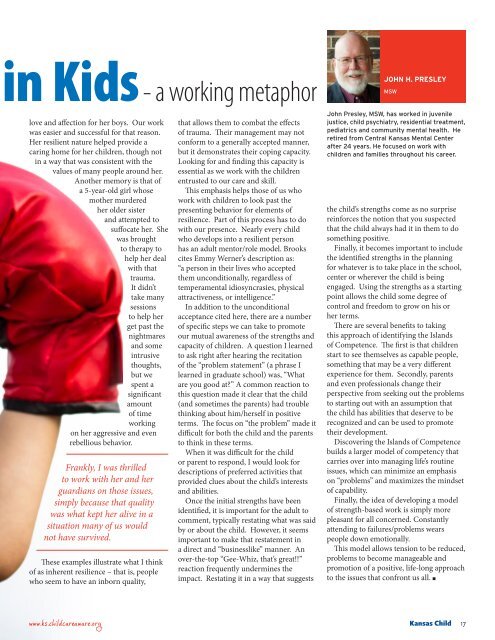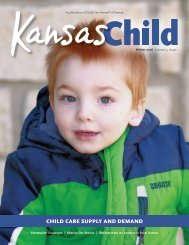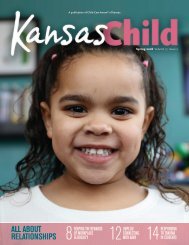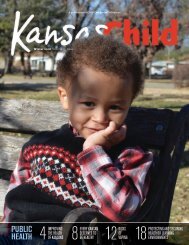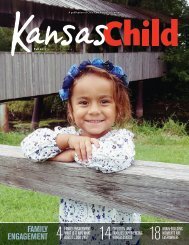2018 Spring Kansas Child
You also want an ePaper? Increase the reach of your titles
YUMPU automatically turns print PDFs into web optimized ePapers that Google loves.
in Kids - a working metaphor<br />
JOHN H. PRESLEY<br />
MSW<br />
love and affection for her boys. Our work<br />
was easier and successful for that reason.<br />
Her resilient nature helped provide a<br />
caring home for her children, though not<br />
in a way that was consistent with the<br />
values of many people around her.<br />
Another memory is that of<br />
a 5-year-old girl whose<br />
mother murdered<br />
her older sister<br />
and attempted to<br />
suffocate her. She<br />
was brought<br />
to therapy to<br />
help her deal<br />
with that<br />
trauma.<br />
It didn’t<br />
take many<br />
sessions<br />
to help her<br />
get past the<br />
nightmares<br />
and some<br />
intrusive<br />
thoughts,<br />
but we<br />
spent a<br />
significant<br />
amount<br />
of time<br />
working<br />
on her aggressive and even<br />
rebellious behavior.<br />
Frankly, I was thrilled<br />
to work with her and her<br />
guardians on those issues,<br />
simply because that quality<br />
was what kept her alive in a<br />
situation many of us would<br />
not have survived.<br />
These examples illustrate what I think<br />
of as inherent resilience – that is, people<br />
who seem to have an inborn quality,<br />
that allows them to combat the effects<br />
of trauma. Their management may not<br />
conform to a generally accepted manner,<br />
but it demonstrates their coping capacity.<br />
Looking for and finding this capacity is<br />
essential as we work with the children<br />
entrusted to our care and skill.<br />
This emphasis helps those of us who<br />
work with children to look past the<br />
presenting behavior for elements of<br />
resilience. Part of this process has to do<br />
with our presence. Nearly every child<br />
who develops into a resilient person<br />
has an adult mentor/role model. Brooks<br />
cites Emmy Werner’s description as:<br />
“a person in their lives who accepted<br />
them unconditionally, regardless of<br />
temperamental idiosyncrasies, physical<br />
attractiveness, or intelligence.”<br />
In addition to the unconditional<br />
acceptance cited here, there are a number<br />
of specific steps we can take to promote<br />
our mutual awareness of the strengths and<br />
capacity of children. A question I learned<br />
to ask right after hearing the recitation<br />
of the “problem statement” (a phrase I<br />
learned in graduate school) was, “What<br />
are you good at?” A common reaction to<br />
this question made it clear that the child<br />
(and sometimes the parents) had trouble<br />
thinking about him/herself in positive<br />
terms. The focus on “the problem” made it<br />
difficult for both the child and the parents<br />
to think in these terms.<br />
When it was difficult for the child<br />
or parent to respond, I would look for<br />
descriptions of preferred activities that<br />
provided clues about the child’s interests<br />
and abilities.<br />
Once the initial strengths have been<br />
identified, it is important for the adult to<br />
comment, typically restating what was said<br />
by or about the child. However, it seems<br />
important to make that restatement in<br />
a direct and “businesslike” manner. An<br />
over-the-top “Gee-Whiz, that’s great!!”<br />
reaction frequently undermines the<br />
impact. Restating it in a way that suggests<br />
John Presley, MSW, has worked in juvenile<br />
justice, child psychiatry, residential treatment,<br />
pediatrics and community mental health. He<br />
retired from Central <strong>Kansas</strong> Mental Center<br />
after 24 years. He focused on work with<br />
children and families throughout his career.<br />
the child’s strengths come as no surprise<br />
reinforces the notion that you suspected<br />
that the child always had it in them to do<br />
something positive.<br />
Finally, it becomes important to include<br />
the identified strengths in the planning<br />
for whatever is to take place in the school,<br />
center or wherever the child is being<br />
engaged. Using the strengths as a starting<br />
point allows the child some degree of<br />
control and freedom to grow on his or<br />
her terms.<br />
There are several benefits to taking<br />
this approach of identifying the Islands<br />
of Competence. The first is that children<br />
start to see themselves as capable people,<br />
something that may be a very different<br />
experience for them. Secondly, parents<br />
and even professionals change their<br />
perspective from seeking out the problems<br />
to starting out with an assumption that<br />
the child has abilities that deserve to be<br />
recognized and can be used to promote<br />
their development.<br />
Discovering the Islands of Competence<br />
builds a larger model of competency that<br />
carries over into managing life’s routine<br />
issues, which can minimize an emphasis<br />
on “problems” and maximizes the mindset<br />
of capability.<br />
Finally, the idea of developing a model<br />
of strength-based work is simply more<br />
pleasant for all concerned. Constantly<br />
attending to failures/problems wears<br />
people down emotionally.<br />
This model allows tension to be reduced,<br />
problems to become manageable and<br />
promotion of a positive, life-long approach<br />
to the issues that confront us all. n<br />
www.ks.childcareaware.org <strong>Kansas</strong> <strong>Child</strong> 17


